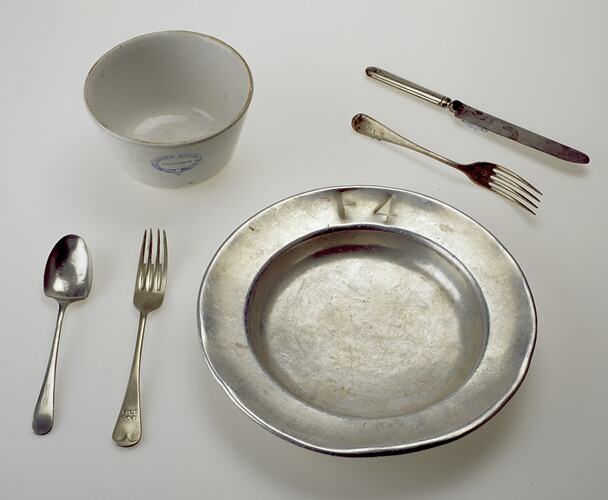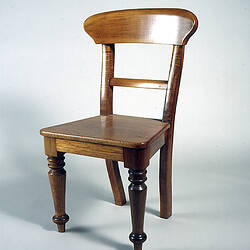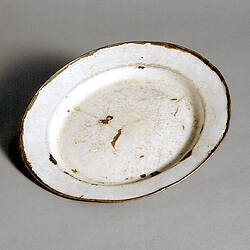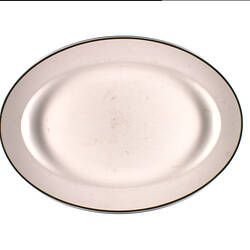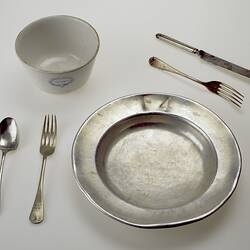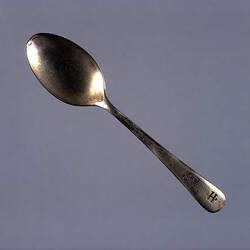Summary
An account of patient dining facilities at psychiatric hospitals in Victoria Australia from 1885 to 1970.
Dining in Victorian Mental Health Institutions In August 1885, Dr George Tucker, a private asylum proprietor recently returned from an extensive overseas tour of institutions for the mentally ill and inspected the Kew and Yarra Bend Asylums. At Kew, he observed the patients whilst at 'dinner, the mid-day meal'. While he considered the food 'amply sufficient and sufficiently cooked', he found the serving of the meal 'demoralising'.
In a ward of about thirty-three patients, he observed only a single table: 'that would seat about eight patients.the meat is cut up upon a rough board upon the table, the patients taking their food at the same table, say eight patients, four on each side, served in broken battered tins. There were three pint mugs in the centre of the table, with broken handles, for the whole of the eight patients to drink water out of, and two salt cellars. The knives and forks were extremely dirty; the whole morale and conduct of the dinner was degrading to any man or woman; nothing to raise or exalt, or to cause a better state of feeling on behalf of the patients' (Report of the Royal Commission on Asylums for the Insane and Inebriate 1886, Minutes of Evidence, Q.10844, pp.464-5).
Those not seated at the table in the dining room ate their meal in the day-room, which also served as a corridor, 'some with food in their hands, and some with it in tin dishes' (Report of the Royal Commission on Asylums for the Insane and Inebriate, Victoria, 1886, Minutes of Evidence, Q.10844, pp.464-5).
Twenty years later, the recently appointed head of the Lunacy Department, Dr W Ernest Jones echoed Tucker's criticisms, declaring that he 'had frequently to complain of the crude methods of cooking, and the untidy and unappetising way the food is served on the patients' dining tables' (Report of the Inspector-General of the Insane 1905, p.25). Paul Ward Farmer, who in 1900 published an account of his three-week confinement to Kew, had certainly found the meals disconcerting, writing that 'after being accustomed to having everything daintily served' he 'did not care for the rough way of eating'. He objected even more 'to see Lunatic Asylum in blue letters upon every cup and plate, so that we were never able to get away from the fact that we were lunatics' (Farmer, 1900, 6, p.21). By 1906, Jones was attempting to improve the patients' dining experience, by 'gradually eliminating tin and enamelled ware and replacing it by stoneware. 'Glass tumblers and proper cups and saucers will ultimately replace the china mugs now in use' (Report of the Inspector-General of the Insane 1905, p.25).
Despite these efforts, the patients' meals continued to be dismal affairs. In 1948, a report on the mental hospitals observed that they were 'in most cases unappetisingly served.Dining-rooms on the whole are bare and chilly. The crockery is appalling and depressive.There are few tablecloths, table covers, and painted tables' (Mental Hospitals' Inquiry, 1948, p.9). Dr Eric Cunningham Dax, appointed Chairman of the Mental Hygiene Authority in 1952, found the 'serving of the food and its presentation' he observed on his arrival 'revolting', describing the young patients at Kew Cottages eating 'with their hands out of tin bowls' (Dax, 1961, p.20).
During the 1950s and 1960s, Dax and his colleague, Eric Ebbs, tackled another serious and long-standing concern about institutional dining, namely that meals frequently arrived at ward dining rooms cold, and therefore affecting their palatability. A trial of insulated food containers proved unsuccessful as they tended to crack along their edges after long use and their cork insulation became saturated with liquid from the food. Rotting food in the cork insulation 'caused severe health risk in some hospitals' (Minutes of the 144th meeting of the Advisory Committee to the Mental Hygiene Authority, 7 July 1959, p.1). Food trolleys proved to be the ultimate solution and by 1970 at the Ararat Mental Hospital, meals were said to be satisfactorily warm when they arrived at wards (Minutes of the 347th meeting of the Advisory Committee to the Mental Health Authority, 14-16 November 1970, p.1).
Authors - Dr Ann Westmore and Dr Lee-Ann Monk
References
Dax, Eric Cunningham (1961), Asylum to Community: The Development of the Mental Hygiene Service in Victoria, Australia, Melbourne, F W Cheshire.
Farmer, Paul Ward (1900), Three Weeks in the Kew Lunatic Asylum, Melbourne, John J Halligan.
Mental Hospitals' Inquiry Committee (March 1948), Report on the Department of Mental Hygiene, Its Hospitals, and Its Administration, Melbourne, Government Printer
Report of the Royal Commission on Asylums for the Insane and Inebriate, Victoria (1886), Victorian Parliamentary Papers, Vol. II
Report of the Inspector-General of the Insane 1905, (1906), Victorian Parliamentary Papers, Vol. II
Minutes of the 144th meeting of the Advisory Committee to the Mental Hygiene Authority, 7 July 1959, SLV Mental Health Auxiliaries Collection, MS PA 89/140, Box 3/13, p 1
Minutes of the 347th meeting of the Advisory Committee to the Mental Health Authority, 14-16 November 1970, SLV Mental Health Auxiliaries Collection, MS PA 89/140, Box 3/13, p 1
More Information
-
Keywords
-
Authors
-
Article types
